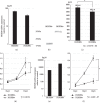Identification of a Modified HOXB9 mRNA in Breast Cancer
- PMID: 32104178
- PMCID: PMC7040399
- DOI: 10.1155/2020/6065736
Identification of a Modified HOXB9 mRNA in Breast Cancer
Abstract
First identified as a developmental gene, HOXB9 is also known to be involved in tumor biological processes, and its aberrant expression correlates with poor prognosis of various cancers. In this study, we isolated a homeodomain-less, novel HOXB9 variant (HOXB9v) from human breast cancer cell line-derived mRNA. We confirmed that the novel variant was produced from variationless HOXB9 genomic DNA. RT-PCR of mRNA isolated from clinical samples and reanalysis of publicly available RNA-seq data proved that the new transcript is frequently expressed in human breast cancer. Exogenous HOXB9v expression significantly enhanced the proliferation of breast cancer cells, and gene ontology analysis indicated that apoptotic signaling was suppressed in these cells. Considering that HOXB9v lacks key domains of homeobox proteins, its behavior could be completely different from that of the previously described variationless HOXB9. Because none of the previous studies on HOXB9 have considered the presence of HOXB9v, further research analyzing the two transcripts individually is warranted to re-evaluate the true role of HOXB9 in cancer.
Copyright © 2020 Ayako Nakashoji et al.
Conflict of interest statement
The authors declare that there are no conflicts of interest regarding the publication of this paper.
Figures







Similar articles
-
The role of HOXB9 and miR-196a in head and neck squamous cell carcinoma.PLoS One. 2015 Apr 10;10(4):e0122285. doi: 10.1371/journal.pone.0122285. eCollection 2015. PLoS One. 2015. PMID: 25860510 Free PMC article.
-
HOXB9 expression promoting tumor cell proliferation and angiogenesis is associated with clinical outcomes in breast cancer patients.Ann Surg Oncol. 2012 Jun;19(6):1831-40. doi: 10.1245/s10434-012-2295-5. Epub 2012 Mar 7. Ann Surg Oncol. 2012. PMID: 22396001
-
Endocrine disrupting chemical, bisphenol-A, induces breast cancer associated gene HOXB9 expression in vitro and in vivo.Gene. 2016 Sep 30;590(2):234-43. doi: 10.1016/j.gene.2016.05.009. Epub 2016 May 13. Gene. 2016. PMID: 27182052 Free PMC article.
-
Experimental and clinicopathological analysis of HOXB9 in gastric cancer.Oncol Lett. 2019 Mar;17(3):3097-3102. doi: 10.3892/ol.2019.10008. Epub 2019 Feb 4. Oncol Lett. 2019. PMID: 30867739 Free PMC article.
-
Involvement of the multiple tumor suppressor genes and 12-lipoxygenase in human prostate cancer. Therapeutic implications.Adv Exp Med Biol. 1997;407:41-53. doi: 10.1007/978-1-4899-1813-0_7. Adv Exp Med Biol. 1997. PMID: 9321930 Review.
Cited by
-
Comprehensive analysis of the homeobox family genes in breast cancer demonstrates their similar roles in cancer and development.Breast Cancer Res Treat. 2021 Apr;186(2):353-361. doi: 10.1007/s10549-020-06087-2. Epub 2021 Jan 18. Breast Cancer Res Treat. 2021. PMID: 33459920
References
LinkOut - more resources
Full Text Sources
Research Materials

